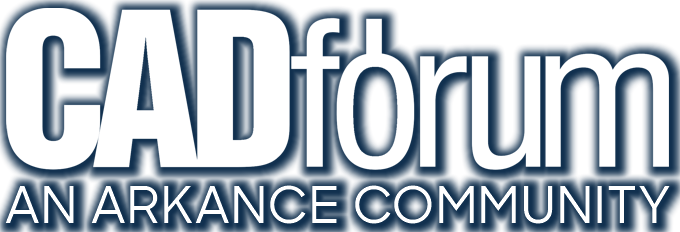Over 1.108.000 registered users (EN+CZ).
AutoCAD tips, Inventor tips, Revit tips, Civil tips, Fusion tips.
Try the updated Units converter and the new precise Engineering calculator.
New AutoCAD 2026 commands and sys.variables and env.variables,.
 Discussion forum
Discussion forum
?CAD discussions, advices, exchange of experience
 CAD discussion forum - ask any CAD-related questions here, share your CAD knowledge on AutoCAD, Inventor, Revit and other Autodesk software with your peers from all over the world. To start a new topic, choose an appropriate forum.
CAD discussion forum - ask any CAD-related questions here, share your CAD knowledge on AutoCAD, Inventor, Revit and other Autodesk software with your peers from all over the world. To start a new topic, choose an appropriate forum.
Please abide by the rules of this forum.
This is a peer-to-peer forum. The forum doesn't replace the official direct technical support provided by ARKANCE for its customers.
How to post questions: register or login, go to the specific forum and click the NEW TOPIC button.
|
Post Reply 
|
Page 12> |
| Author | |
jbaylie 
Newbie 
Joined: 29.Mar.2013 Location: United States Using: AutoCAD2013 Status: Offline Points: 3 |
 Topic: Legal Description Question Topic: Legal Description QuestionPosted: 29.Mar.2013 at 01:11 |
|
I am trying to draw a legal description in autoCAD 2013, i have formatted my drawing units to surveryos units and i was going along just fine until i got to a curve.
How do i continue my drawing and add the curve? this is what I am given: "Thence along a curve to the right having a central angle of 19'21'33. A radius of 694.26 feet. An arc length of of 234.58 feet and a chord that bears north 35d29'19"" I dont know what to do with that information so that it will draw it the correct arc.....PLEASE HELP
Edited by jbaylie - 29.Mar.2013 at 01:14 |
|
 |
|
John Connor 
Senior Member 
Joined: 01.Feb.2011 Location: United States Using: AutoCAD 2018 Status: Offline Points: 7175 |
 Posted: 29.Mar.2013 at 11:09 Posted: 29.Mar.2013 at 11:09 |
|
That's a typical horizontal curve which anyone familiar with basic math should know how to construct. You have all the information you need (angle and radius) plus some extra (arc length and chord). Try an Internet search for "horizontal curve" and you'll see how one is constructed. Remember that your radius has to be perpendicular to the property lines on either side of the curve.
|
|
|
"Humans have a strength that cannot be measured. This is John Connor. If you are reading this, you are the resistance."
<<AutoCAD 2015>> |
|
 |
|
jbaylie 
Newbie 
Joined: 29.Mar.2013 Location: United States Using: AutoCAD2013 Status: Offline Points: 3 |
 Posted: 29.Mar.2013 at 14:19 Posted: 29.Mar.2013 at 14:19 |
|
did not say it was hard, i sadi i was stuck. I looked it up on the internet and got here, i figured this was the place but i guess not. |
|
 |
|
philippe JOSEPH 
Senior Member 
Joined: 14.Mar.2011 Location: France Using: AutoCAD Mechanical 2017 Status: Offline Points: 1518 |
 Posted: 29.Mar.2013 at 14:35 Posted: 29.Mar.2013 at 14:35 |
|
uploads/175428/CURVE01_A.dwg
Hello John, please tell me ( us ) if it's ok because it's also not too much easy for me ( including the barrier of the language and units of course ).
|
|
 |
|
John Connor 
Senior Member 
Joined: 01.Feb.2011 Location: United States Using: AutoCAD 2018 Status: Offline Points: 7175 |
 Posted: 29.Mar.2013 at 21:48 Posted: 29.Mar.2013 at 21:48 |
|
Draw a circle with the given radius.
Draw a line from the center of the circle to the easterly quadrant of the circle. Draw a second line using the direct distance entry method (at the command line) as follows... @694.26'<19d21'33" Trim the circle leaving the arc between the two lines you drew intact. That's your curve. Now go do it for your property map. |
|
|
"Humans have a strength that cannot be measured. This is John Connor. If you are reading this, you are the resistance."
<<AutoCAD 2015>> |
|
 |
|
CarlB 
Senior Member 
Joined: 16.Oct.2009 Location: United States Status: Offline Points: 321 |
 Posted: 30.Mar.2013 at 01:21 Posted: 30.Mar.2013 at 01:21 |
|
The last line you drew prior to the curve should be tangent to the curve (or description would have said "non-tangent"). Offset this line to the right, a distance equal to the curve radius. The end of the offset line will be the center of the curve. Draw a line between those endpoints, rotate that line by the central angle, this will set the end of the curve. Draw a circle and trim to get desired curve.
|
|
 |
|
philippe JOSEPH 
Senior Member 
Joined: 14.Mar.2011 Location: France Using: AutoCAD Mechanical 2017 Status: Offline Points: 1518 |
 Posted: 02.Apr.2013 at 10:04 Posted: 02.Apr.2013 at 10:04 |
|
Ok John and CarlB for the central angle of 19d21'33, radius of 694.26 giving an arc of 234.58 feet but where is the chord bearing north 35d29'19" ?
Please take a look at my uploaded drawing CURVE01_A.dwg for me ( us ) understanding better ( or understanding at all ).
|
|
 |
|
Kent Cooper 
Senior Member 
Joined: 12.Mar.2013 Location: United States Using: AutoCAD2020, 2023 Status: Offline Points: 687 |
 Posted: 02.Apr.2013 at 16:00 Posted: 02.Apr.2013 at 16:00 |
|
uploads/353260/ArcLength.lsp
Try out the attached ArcLength.lsp with its ARCL command [a new .LSP version I just made of what I've had as a screen menu item for many years] -- a way to draw an Arc including specifying the LENGTH ALONG THE CURVE [an aspect you can't use in AutoCAD's ways of drawing Arcs, unless that's been changed in a newer version than mine]. It was designed for property-description Arcs like your example. It asks for the start point [defaulting to the last point, usually of a preceding Line but including getting it right for a preceding Arc if that was drawn with this command], starting direction [defaulting to tangent continuation as is so often the case in property boundaries], radius, length along the Arc, and whether it curves left or right.
At this point that's the only variety of Arc it draws, but I may work on a version, or an option in this, to specify by length and direction of chord.
|
|
 |
|
CarlB 
Senior Member 
Joined: 16.Oct.2009 Location: United States Status: Offline Points: 321 |
 Posted: 03.Apr.2013 at 03:08 Posted: 03.Apr.2013 at 03:08 |
|
The chord is the straight line from beginning to end of the curve. You have it in your drawing. if you change units to "survey" and list the line, it reads:
LINE Layer: "0" Space: Model space Handle = 12e86 from point, X=68'-6.90566369" Y=63'-1.85544090" Z=0'-0.00000000" to point, X=57'-3.37070543" Y=47'-3.76252329" Z=0'-0.00000000" Length =19'-5.46314963", Angle in XY Plane = S 35d29'19.0000" W A line with bearing SxxxxW is same as one of NxxxxE (just reversed endpoints). The original poster neglected to specify a "W" or "E" at the end of the chord bearing. |
|
 |
|
philippe JOSEPH 
Senior Member 
Joined: 14.Mar.2011 Location: France Using: AutoCAD Mechanical 2017 Status: Offline Points: 1518 |
 Posted: 03.Apr.2013 at 07:45 Posted: 03.Apr.2013 at 07:45 |
|
Hello CarlB, thanks again for your explanations ( I know what is a chord, an arc, an arrow ).
I just wanted to know if the drawing was in the good direction towards the north with the OP informations :
A curve to the RIGHT ............a chord that bears north 35d29'19".
I have AutoCAD Mechanical 2012 and when I use the command UNITS I get the palette that you can see in my drawing ( unité de dessin ) and I don't have "survey" but :
Architecture, Décimal, Fractionnaire, Ingénierie ( that I choose ) and Scientifique ( It's written in my AutoCAD french release but I'm sure that you can understand it very well ).
Can you update my drawing with the right units setings, rotate the chord to the right angle towards the north and upload it again ?
By the way we don't have any news from jbaylie, have you done your drawing allright ?
|
|
 |
|
Post Reply 
|
Page 12> |
|
Tweet
|
| Forum Jump | Forum Permissions  You cannot post new topics in this forum You cannot reply to topics in this forum You cannot delete your posts in this forum You cannot edit your posts in this forum You cannot create polls in this forum You cannot vote in polls in this forum |
This page was generated in 0,169 seconds.
![CAD Forum - tips, tricks, discussion and utilities for AutoCAD, Inventor, Revit and other Autodesk products [www.cadforum.cz] CAD Forum - tips, tricks, discussion and utilities for AutoCAD, Inventor, Revit and other Autodesk products [www.cadforum.cz]](/common/arkance_186.png)









 Legal Description Question
Legal Description Question Topic Options
Topic Options


